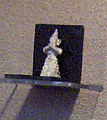Bronze triangle from Heddernheim
The bronze triangle of Heddernheim is a Roman votive sheet made of bronze for Jupiter Dolichenus , whose cult can be traced back to the weather god of Aleppo . It was found at the Nordwestzentrum , Frankfurt am Main and comes from the Roman settlement of Nida . The bronze triangle came into the art trade at the beginning of the 19th century. Today it is in the Nassau antiquities collection in Wiesbaden.
Description and interpretation
The bronze triangle is visually divided into three registers, in which various deities are represented. The iconography shows clear parallels to Syrian and Anatolian depictions of the Bronze and Iron Ages . It is evident that the artist had a good knowledge of oriental symbolism.
In the lower register, Juno Dolichena stands on a rind, to the left and right are two bearded mountain gods with raised hands and each with a human bust above. The representation of the mountain gods resembles astonishingly strong Hittite representations, where they are depicted with a scaled skirt symbolizing rocks. These are shown as five balls on the bronze triangle, the original skirt was replaced by the Roman military uniform. The human busts and Juno Dolichena have no direct parallels in Anatolian and Syrian iconography.
In the middle register, the bearded Jupiter Dolichenus stands on a bull. As with many Iron Age depictions of the Luwian weather god Tarhunza from Syria, he has the typical braid . In the right he holds a double ax and in the left a bundle of lightning , while the Syrian predecessors hold a simple ax and a simple upward bundle of lightning. The sword and the short apron are also oriental heritage, only that the clothing, as with the mountain gods, was adapted to the Roman military uniform.
The upper register shows the goddess of victory Victoria and the bust of the sun god Sol , the lower edge of which forms a crescent moon. This representation is a novelty compared to the usual Jupiter Dolichenus accompaniment of Sol, Luna and an eagle. This trinity has its model in the ancient oriental winged sun , which represents a sign of rule and, with gods, also of heavenly power. Originally a symbol of the sun, it could later be combined with the crescent moon and was then dissolved into sun, moon and eagle in Roman times.
A striking feature of the Heddernheim bronze triangle is the depiction of the two mountain gods below the god. This is strongly reminiscent of the depiction of the weather god Teššub in the Hittite rock sanctuary of Yazılıkaya , who is represented standing on two mountain gods. This motif is also found frequently on Hittite seals.
Bronze and Iron Age precursors
Weather god of Aleppo from Tell Ahmar (9th century BC)
literature
- Guy Bunnens: The Storm-God in Northern Syria ans Southern Anatolia from Hadad of Aleppo to Jupiter Dolichenus . In: Manfred Hutter; Official religion, local cults and individual religiosity ; Ugarit-Verlag (2004). ISBN 3-934628-58-3 . Pp. 57-82
Individual evidence
- ↑ Guy Bunnens: The Storm-God in Northern Syria ans Southern Anatolia from Hadad of Aleppo to Jupiter Dolichenus . P. 69



